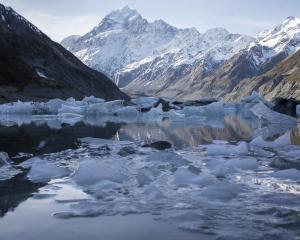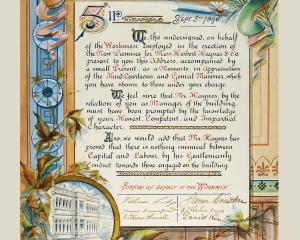
Rae Campbell doesn't use an air freshener in her car, although it has a fresh eucalyptus scent.
That's because she goes out twice a day to cut fresh gum leaves for her koala, Honey.
Known as the "Koala Mum" for her work in mothering orphaned animals, Rae is the only private individual to be permitted to have her own koala.
"I have the only licence in all Australia to keep a koala in permanent captivity outside a zoo or licensed wildlife park," Rae explains.
"She's been raised by me from when she was a few weeks old, so she can't go back to the wild."
Honey was rescued from her mother's pouch after her dam was killed on the road, an all-too-common fate for the Australian animal.
Rae says: "I had a phone call at about 2.30am one morning, which isn't unusual, requesting me to go to [Adelaide's] South Eastern Freeway to collect a koala that had been hit by a car, and to take it to the all-night vet.
"When I arrived, I found that the beautiful girl had passed, but on checking her pouch, I found a tiny scrap of life still clinging to her mum's teat. That was Honey's introduction to the big wide world. I always carry heat packs and pouches, just in case, and these were put immediately to good use."
As Honey was hairless, heat was vital, as was suitable food.

"At home I have a type of humidicrib, and this became her abode for several months, emerging every few hours to be fed, toiletted et cetera," Rae says.
Honey's companion was a teddy from which Rae had removed the body filling, replacing it with a heat pack, plus a clock to simulate her mother's heartbeat.
Four years on, she has become the face of Rae's campaign to save the increasingly endangered southern koala.
Rae has always had a soft spot for animals in trouble and admits: "From the age of 3, I took home everything."

After her marriage to Warren at "the ripe old age of 17 years", Rae left Adelaide for a sheep station on edge of the Nullarbor Plain, where farming life and raising six children didn't stop her animal rescue work.
There were no koalas but she recalls mothering "hundreds of wombats and kangaroos - and lambs, of course" but her most remarkable rescues at that time were eight wedge-tailed eagles, Australia's largest birds of prey, with wingspans of 3m.
When the Campbells returned to Adelaide in 1970, koalas became the focus of their wildlife-rescue work.
"One week, we had 15 koalas on drips in our lounge," Rae says.
Their tiniest success was Kao, who weighed just 52g when the Campbells took her. They fed her hourly for more than eight months.
Kao went on to get the royal seal of approval, meeting Prince Charles at his request in 2012, while another rescue koala, Matilda, got cuddles from Camilla.
At the beginning of 2014, Rae opened the Adelaide Koala and Wildlife Hospital, which she called "the answer to a dream". Unfortunately, Warren was unable to share this highlight, as he had died eight months earlier. Rae later received an award made posthumously in recognition of his work.
These days, her focus is on setting up a larger facility within the new Glenthorne National Park. She has been a member of the Friends of Glenthorne for 22 years, as the group fought for the park to be established instead of the land being used for housing. The plan is to include an RSPCA hospital and a wildlife area and Rae is committed to seeing these reach fruition.
"I am very proud to have been appointed as the ambassador for [South Australia's] new Glenthorne National Park and as well as a koala `soft-release' programme, I hope to open a conservation and education centre in the park," she says.
Saving the koalas is vital, she says, adding: "They're the little Aussies we don't want to lose."
Habitat loss is a major issue, pushing the animals into urban environments where they are at risk on the roads and vulnerable to dog attacks.
Earlier this year, residents of a retirement complex only a couple of kilometres from the centre of Adelaide were thrilled to see a koala sleeping in one of the property's trees, an example of what is happening.
Rae is pushing for more safe road crossings but admits bureaucrats are frustratingly slow to move on this.
"Koalas can eat only 12 of our 300 eucalyptus species [so] they're coming in from other areas because the trees have been cut down."
Honey doesn't have those problems because Rae collects gum leaves for her and at home she is either in her purpose-built run or inside, cuddling up with the family cat, Pumpkin.
Now four years old, Honey is close to maturity but there are no plans to find her a mate.
"She'll always be a spinster," Rae says.
National symbols
Like kangaroos, koalas are identified as Australian symbols but despite this, they are increasingly threatened. Although an estimated 80,000 remain in the wild, put that alongside the 8 million skins that were exported from Adelaide between 1890 and 1930, and the level of losses becomes apparent.
The skin trade resulted in the extinction of koalas from South Australia and those seen now are mainly descendants of 18 animals taken in 1927 from Victoria — which has the same species — to Kangaroo Island, which had never had koalas.
The Kangaroo Island population is threatened now by calls to kill them, as eucalyptus oil producers want koala numbers reduced to take away competition.
The issue is that koalas eat one of the species the oil industry uses, hence the calls for widespread culling on the island.
Rae Campbell says: ‘‘Although humans are the koalas’ greatest enemy, we are their only hope of survival, so someone has to start with one small step if we are
to save them from extinction.’












